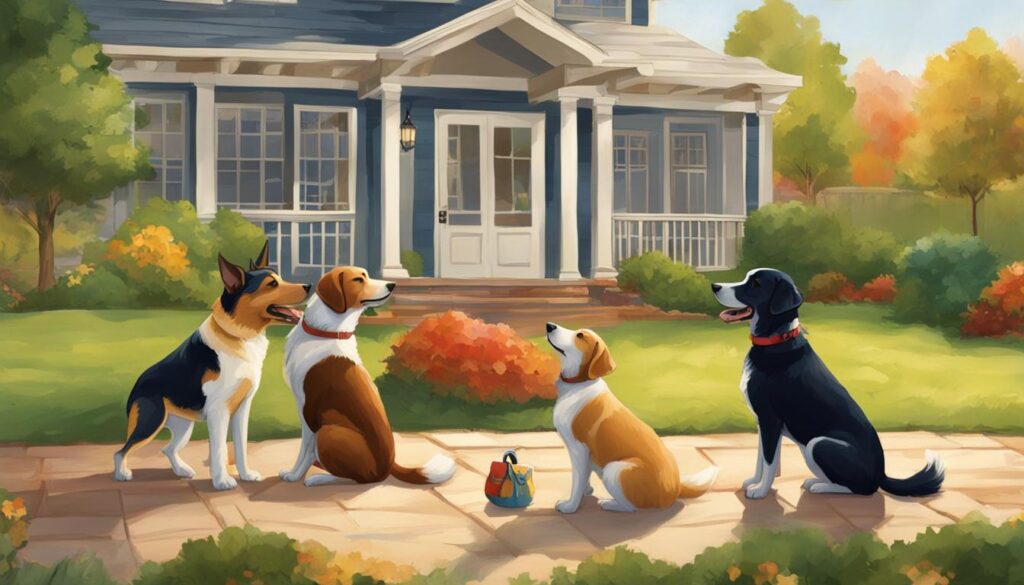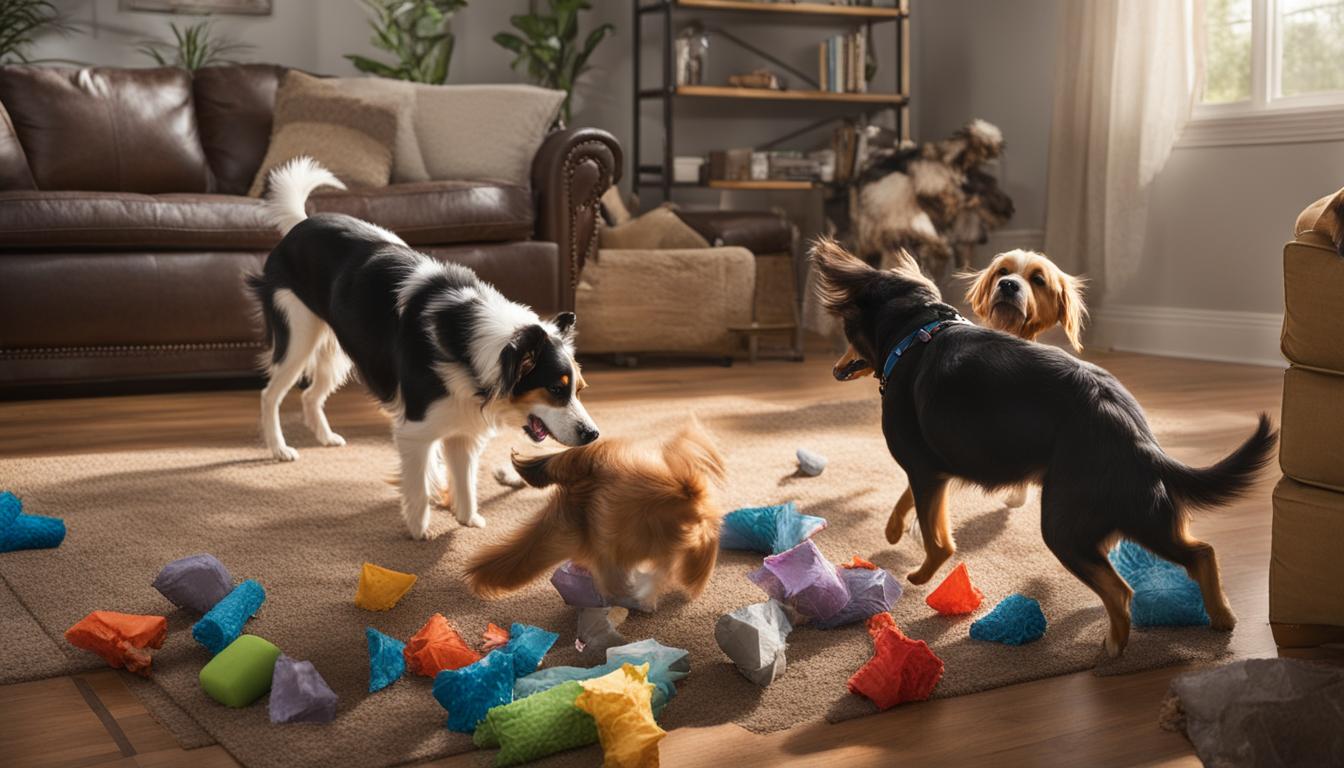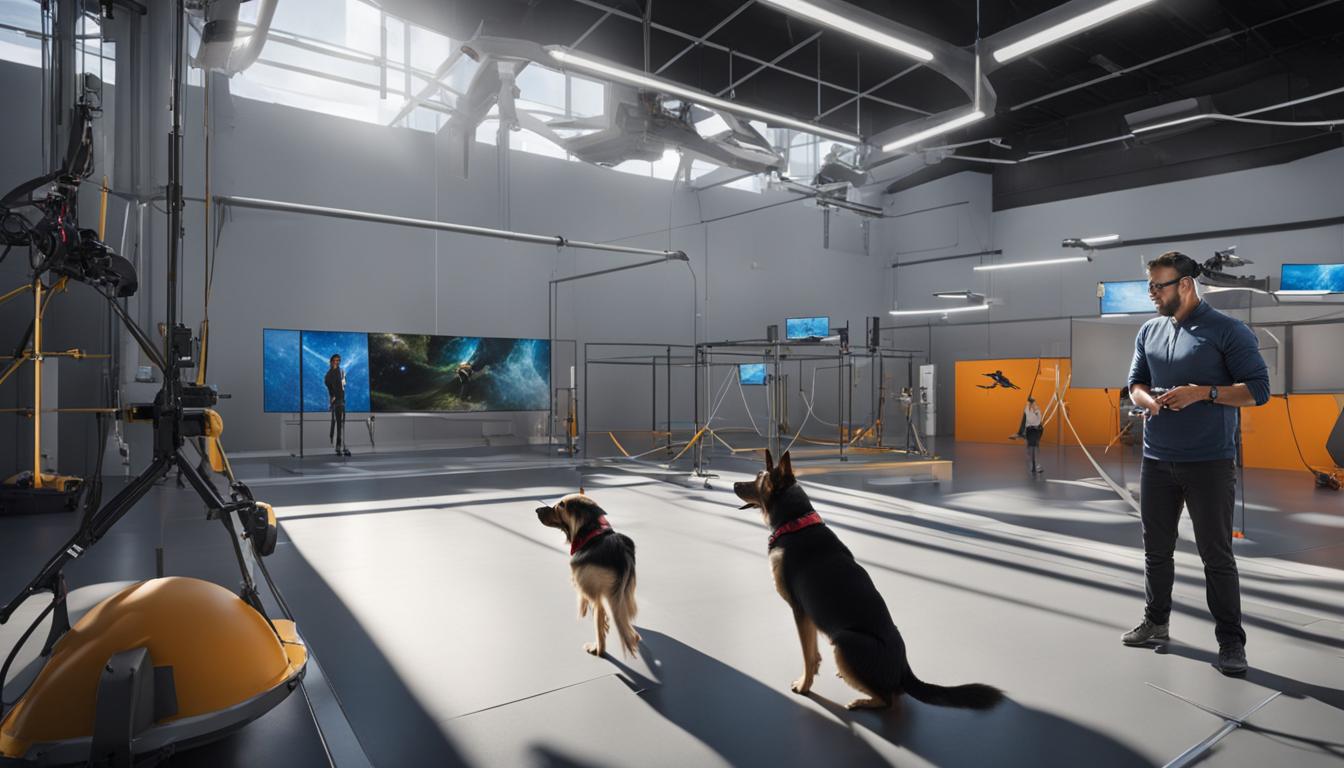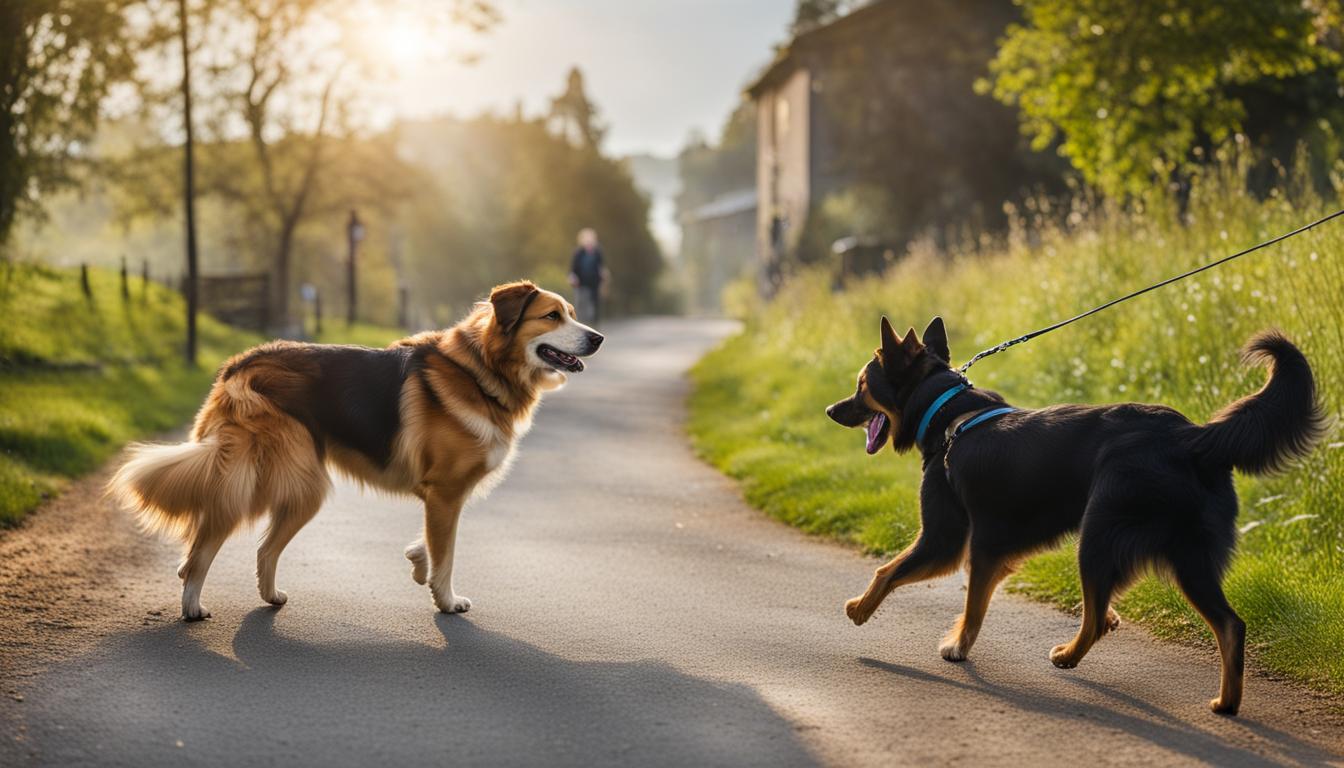Welcome to the wonderful world of multi-dog households! Living with multiple dogs can bring immense joy and companionship, but it also comes with its fair share of challenges. From balancing attention among furry family members to resolving conflicts that may arise, maintaining harmony and balance is essential for a peaceful coexistence.
In this article, we will explore effective strategies that will help you navigate the common challenges faced in multi-dog households. By understanding the dynamics of pack behavior, choosing compatible packmates, and implementing practical techniques, you can create a harmonious and balanced environment for both yourself and your furry friends.
Key Takeaways:
- Living in a multi-dog household requires effort, understanding, and effective management
- Choosing compatible packmates based on breed predispositions and temperament is important
- Clear boundaries, proper training, and managing feeding time are crucial for maintaining balance
- Conflicts can be managed by identifying specific areas of tension and implementing appropriate strategies
- Addressing the root causes of aggression, such as resource guarding, is vital for a peaceful pack
Selecting Canine Family Members for A Peaceful Pack
When building a multi-dog household, it’s important to consider the genetic predispositions and temperament of the potential packmates. Dogs developed a highly ritualized language to maintain pack order and harmony, but different breeds have varying levels of pack tolerance. Choosing dogs from breeds known for their pack harmony, such as hounds and sporting breeds, can make it easier to create a peaceful pack. However, with proper training and management, even breeds with lower pack tolerance, like Pit Bulls or terriers, can live together successfully.
Establishing clear boundaries, managing feeding time, and providing effective training for each dog are key components of maintaining balance in a multi-dog household. Creating a feeding schedule and designated areas for each dog during mealtimes can help prevent conflicts and resource guarding. Training multiple dogs effectively involves consistent rules and commands that all pack members understand. It’s crucial to provide individual attention and engage in regular training sessions with each dog to reinforce their place within the pack hierarchy.
Building a peaceful pack also requires setting and enforcing boundaries. This can be done through the use of baby gates, crates, or designated spaces for each dog. Providing separate sleeping areas and toys can help minimize territorial disputes. It’s important to remember that while dogs are social animals, they also need their own space and time to relax. Respecting their boundaries and ensuring they have a safe and comfortable environment is essential for a harmonious multi-dog household.
Managing Conflict Situations
Resolving conflicts in multi-dog households is essential for maintaining a harmonious and peaceful pack dynamic. Dogs, like humans, can experience sibling rivalry, which can result in tension and aggression. Understanding how to manage these conflict situations is crucial to creating a balanced and happy multi-dog environment.
Identifying Areas of Conflict
In order to effectively resolve conflicts, it’s important to identify the specific areas where they occur. Common conflict situations in multi-dog households include feeding time, going outside, watching TV, playing, getting home from work, and bedtime. By pinpointing these triggers, you can develop strategies to prevent conflicts from arising.
Strategies for Conflict Resolution
Once you’ve identified the areas of conflict, you can implement management plans and training strategies to address them. Here are some strategies to consider:
- Feeding dogs separately: Providing separate feeding areas for each dog can help prevent resource guarding and reduce conflict during mealtime.
- Using baby gates or tethers: Controlling access to the outdoors with baby gates or tethers can help prevent conflicts over territory and establish boundaries.
- Designated spaces: Providing each dog with their own designated space during TV time or bedtime can help minimize tension and create a sense of security.
- Supervising play sessions: Keeping a close eye on play sessions and intervening when necessary can prevent conflicts from escalating.
Integrating New Dogs
Integrating a new dog into a multi-dog household requires a gradual and controlled introduction process. This can help minimize tension and establish positive relationships. By following a careful introduction plan, you can increase the chances of successful integration and reduce conflicts between new and existing pack members.

| Step | Action |
|---|---|
| 1 | Introduce the dogs on neutral territory, such as a park, to avoid territorial conflicts. |
| 2 | Gradually increase the amount of time the dogs spend together, supervised and in a controlled environment. |
| 3 | Monitor their interactions closely for signs of aggression or tension, and intervene if necessary. |
| 4 | Provide positive reinforcement, such as treats and praise, to encourage positive interactions between the dogs. |
| 5 | Continue the gradual introduction process until the dogs are comfortable and can coexist peacefully. |
Understanding the Root Causes of Aggression
Aggression in multi-dog households is a common challenge that many pet owners face. It is important to recognize that aggression in dogs is often rooted in stress and resource guarding. Dogs may exhibit possessiveness over food, toys, or territory, leading to conflicts with other pack members. To effectively address aggressive behavior, it is crucial to understand the underlying causes and implement positive training techniques and clear boundaries.
Identifying Triggers
Aggression can manifest in various situations, such as during feeding time or when a dog feels their possessions are being threatened. By identifying the specific triggers that lead to aggression, you can develop management plans and training strategies to mitigate conflicts. For example, feeding dogs separately and rewarding them for calm behavior can help reduce food-related aggression.
Positive Reinforcement and Training
Positive reinforcement is a powerful tool in training dogs and can be particularly effective in addressing aggression. By rewarding desired behaviors and redirecting negative reactions, you can help dogs learn alternative coping mechanisms. Teaching dogs obedience commands, such as “leave it,” can also be beneficial in reducing possessiveness and resource guarding tendencies.
“Aggression in multi-dog households is often rooted in stress and resource guarding. By implementing positive training techniques and establishing clear boundaries, you can create a more harmonious environment.”
Establishing clear boundaries and consistent rules is essential in managing aggression in multi-dog households. Dogs thrive in structured environments where they understand their place in the pack hierarchy. Providing each dog with their own designated space and personal belongings can help minimize conflicts over territory.
Seeking Professional Guidance
If aggression issues persist despite your efforts, it may be beneficial to seek the guidance of a professional dog trainer or behaviorist. They can provide expert advice, personalized training plans, and additional tools to help address aggression and restore harmony in your multi-dog household.
Table: Common Triggers and Aggression Management Strategies
| Trigger | Management Strategy |
|---|---|
| Feeding Time | Feed dogs separately in designated areas |
| Resource Guarding | Teach dogs the “leave it” command and reward non-possessive behavior |
| Territorial Disputes | Establish clear boundaries and provide individual spaces for each dog |
| Interaction with Other Dogs | Supervise and manage social interactions, gradually introducing new dogs |
The Dynamics of Age and Personality
As dogs age, their behavior and preferences may change, impacting the dynamics within a multi-dog household. Younger dogs may become more assertive as they mature, while older dogs may lose some of their ability to command respect. Conflicting personalities among dogs can also lead to misunderstandings and tension. To maintain harmony and balance, it’s essential to understand the individual needs and preferences of each dog.
One important aspect to consider is balancing attention among the dogs in your multi-dog family. Each dog requires individual time and affection to feel loved and valued. By allocating dedicated one-on-one time with each dog, you ensure they receive the attention they crave and reduce the likelihood of jealousy or attention-seeking behaviors.
Additionally, managing playtime in a multi-dog household is crucial. Some dogs may have high energy levels and need more vigorous exercise, while others may prefer gentle play or have physical limitations due to age or health conditions. It’s important to provide appropriate outlets for both mental and physical stimulation, ensuring that each dog’s playtime needs are met. This can include activities such as interactive toys, puzzle games, and supervised group play sessions that consider the individual abilities and preferences of each dog.
| Benefits of Balancing Attention in Multi-Dog Families | Benefits of Managing Playtime in Multi-Dog Households |
|---|---|
|
|
“Balancing attention and managing playtime are key components of maintaining harmony and balance in a multi-dog household. By understanding the individual needs and preferences of each dog, you can ensure that they receive the attention and playtime they require, reducing the likelihood of conflicts and promoting a harmonious pack dynamic.” – Dog Behavior Expert
In summary, maintaining harmony and balance in a multi-dog household requires considering the dynamics of age and personality. By balancing attention and managing playtime based on the individual needs of each dog, you can promote a peaceful and harmonious pack environment. Remember to allocate dedicated one-on-one time for each dog and provide appropriate outlets for their playtime needs. With a thoughtful and tailored approach, you can create a happy and well-balanced canine family.

Furthermore, age-related mobility, vision, and hearing problems can also contribute to misunderstandings and miscommunication between dogs. As dogs age, their behavior and preferences may change, adding an additional layer of complexity to the dynamics within a multi-dog household. Younger dogs may become more assertive as they mature, while older dogs may lose some of their ability to command respect. These age-related changes can lead to conflicts and power struggles.
To create a peaceful multi-dog environment, it’s essential to address any health issues promptly and provide a comfortable and supportive living space that accommodates the specific needs of each dog. This can include providing orthopedic beds or ramps to help dogs with mobility issues, ensuring that their food and water are easily accessible, and adjusting playtime and exercise routines to suit each dog’s abilities. By taking care of their physical well-being, you can help reduce tension and promote a harmonious pack dynamic.
| Benefits of Addressing Health and Mobility: | Strategies for Creating Peaceful Multi-Dog Environments: |
|---|---|
| – Reduced aggression and irritability | – Promptly address any health issues |
| – Better communication and understanding between dogs | – Provide a comfortable and supportive environment |
| – Minimized conflicts and power struggles | – Accommodate specific needs of each dog |
| – Improved overall well-being and quality of life | – Adjust routines and activities to suit abilities |
Conclusion
Living in a multi-dog household can be a wonderful and fulfilling experience, but it also comes with its challenges. However, with the right strategies and commitment, you can create a harmonious and peaceful environment for your pack. By selecting compatible packmates and establishing clear boundaries, you lay the foundation for a balanced multi-dog dynamic.
Resolving conflicts and addressing health issues promptly is crucial to maintaining harmony within your pack. By understanding the root causes of aggression and implementing positive training techniques, you can reduce tension and promote a peaceful coexistence. It’s also important to consider the individual needs and preferences of each dog, providing them with the attention, playtime, and social interaction they require for a balanced life.
Remember, creating a peaceful multi-dog environment requires effort and understanding. By implementing these strategies for harmonious multi-dog living, you’ll create an atmosphere of love, companionship, and joy for both you and your furry friends. So, embrace the challenges, stay committed, and enjoy the rewarding journey of building a peaceful multi-dog household!
FAQ
How can I create a harmonious multi-dog environment?
By being realistic about your expectations, choosing compatible packmates, and implementing strategies for peaceable coexistence.
What factors should I consider when choosing dogs for a multi-dog household?
It’s important to consider the genetic predispositions and temperament of potential packmates. Different breeds have varying levels of pack tolerance, so choosing dogs from breeds known for their pack harmony can make it easier to create a peaceful pack.
How can I prevent conflicts between dogs in a multi-dog household?
Identifying specific areas of conflict and developing management plans and training strategies for each situation is key. Feeding dogs separately, using baby gates or tethers to control access to the outdoors, and providing designated spaces for each dog during TV time can help prevent conflicts.
What are some common root causes of aggression in multi-dog households?
Aggression in multi-dog households is often rooted in stress and resource guarding. Dogs may exhibit possessiveness over food, toys, or territory, leading to conflicts with other pack members.
How can I address conflicts and aggression in a multi-dog household?
Implementing positive training techniques, establishing clear boundaries, and teaching dogs to “leave it” can help reduce resource guarding behavior. Creating a structured and consistent training environment can also contribute to a more harmonious multi-dog living situation.
How do age and personality impact the dynamics within a multi-dog household?
Younger dogs may become more assertive as they mature, while older dogs may lose some of their ability to command respect. Conflicting personalities among dogs can also lead to misunderstandings and tension.
How can I accommodate the specific needs of aging dogs in a multi-dog household?
It’s essential to address any health issues promptly and provide a comfortable and supportive environment that accommodates the specific needs of each dog. This includes managing feeding time and creating a peaceful environment for all dogs.
How can I ensure a happy and peaceful pack dynamic in a multi-dog household?
By selecting compatible packmates, establishing clear boundaries, addressing conflicts and health issues promptly, and providing individual attention, playtime, and training for each dog, you can create a harmonious and balanced multi-dog environment.





